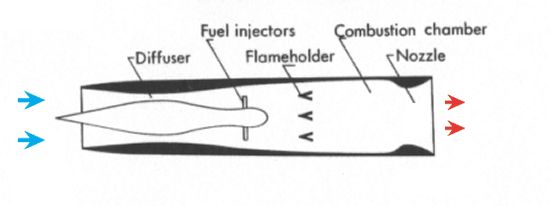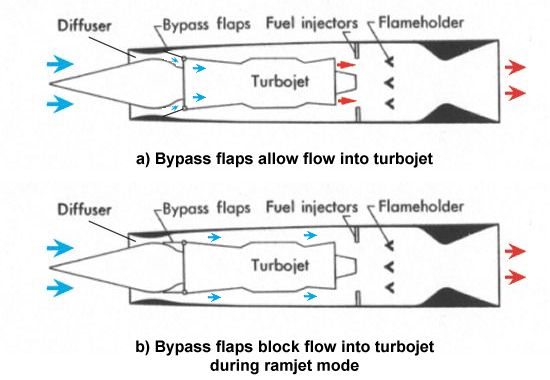|
||||||||||
|
|
||||||||||
|
||||||||||
|
|
||||||||||

The term ramjet is short for ram-air compression. The ramjet is the simplest form of a jet engine because it has no moving parts. This kind of engine is essentially a hollow tube into which fuel is injected, mixed with air, and burned to produce thrust, as illustrated below. The ramjet only works when it is already moving fast enough that the incoming air is compressed simply by being forced into the engine. This behavior is called the ram effect because when a volume of air is forced into a small space at high enough speeds, it is compressed to a higher pressure.

This compression is accomplished in the diffuser section where the incoming air is squeezed into a small area and compressed to a high enough pressure that it can be burned with fuel. Once the fuel is injected, the mixture is fed into a combustion chamber where the fuel-air mixture is ignited to produce a high-speed exhaust. The exhaust passes out the nozzle at the aft end of the engine to produce thrust.
The advantages of the ramjet are its simplicity and its ability to accelerate a vehicle to high speeds over Mach 3. However, we have already pointed out that the engine must already be in motion before it can work, so there is a minimum Mach number that must be reached before a ramjet can be turned on and start producing thrust. Ramjets typically need to be moving faster than Mach 1 before they can be engaged. Compared to the turbojet, ramjets are also usually much less efficient until around Mach 3 or so.
Since a ramjet must already be traveling at high speeds before it will start working, a ramjet-powered aircraft is incapable of taking off from a runway under its own power. That is the advantage of the turbojet, which is a member of the gas turbine family of engines. A turbojet operates much like a ramjet except that it does not rely purely on the motion of the engine to compress the incoming air flow. Instead, the turbojet contains some additional rotating machinery that compresses incoming air and allows the engine to function during takeoff and at slow speeds.

Located just behind the diffuser is a series of rotating fan blades called compressors. As the incoming air passes through these blades, it is slowed down and increasingly compressed to a higher pressure. That pressurized air is then mixed with fuel and ignited in the burner to produce a high-speed flow of air. As that high-speed flow exhausts from the engine, it passes through a stage called the turbine. The turbine is another series of rotating blades that behaves much like a windmill. The flow of air through the blades causes the turbine to rotate and generate power. The turbine and compressor sections are connected together by a shaft so that the rotation of the turbine blades causes the compressor blades to rotate as well. Once the air flow passes through the turbine, it is exhausted through the nozzle to generate thrust.
While the turbine allows a turbojet to operate at low speeds, it is also a limitation on the maximum speed of the engine. High speed flight generates very high temperatures within an engine. As speed increases, these temperatures eventually become so high that the turbine blades melt or break apart and damage the rest of the engine. For this reason, turbojets have traditionally been limited to flight below Mach 3.
Now that we've seen how the ramjet and turbojet work, we can better understand how a turboramjet works. The turboramjet is a hybrid engine that essentially consists of a turbojet mounted inside a ramjet. The turbojet core is mounted inside a duct that contains a combustion chamber downstream of the turbojet nozzle. The turboramjet can be run in turbojet mode at takeoff and during low speed flight but then switch to ramjet mode to accelerate to high Mach numbers.

The operation of the engine is controlled using bypass flaps located just downstream of the diffuser. During low speed flight, these controllable flaps close the bypass duct and force air directly into the compressor section of the turbojet. During high speed flight, the flaps block the flow into the turbojet, and the engine operates like a ramjet using the aft combustion chamber to produce thrust.
During a typical SR-71 flight, the engine would start out operating as a turbojet during takeoff and while climbing to altitude. Upon reaching high subsonic speed, the portion of the engine downstream of the turbojet would be used as an afterburner to accelerate the plane above the speed of sound. Once the aircraft was traveling fast enough, the bypass flaps would block the flow into the turbojet and the engine would begin operating as a ramjet to accelerate to cruise speed. The SR-71 typically flew between Mach 3 and 3.5 during cruise flight, speeds at which the turbojet could not function because of the temperature limitations of its turbine blades.
This design approach gave the SR-71 the ability to operate from zero speed to Mach 3+ using the best features of
both the turbojet and ramjet combined into a single engine. Today, researchers are working on new classes of jet
engines that may be able to accomplish the same mission with a much simpler design. Recent developments in
advanced materials capable of surviving higher temperatures may make it possible to build turbine blades that can
operate beyond Mach 4. This technology is being explored in a program called the Revolutionary Approach To Time
Critical Long Range Strike (RATTLRS). RATTLRS is part of the National Aerospace Initiative and is a cooperative
effort between the US Navy, US Air Force, and NASA. The Navy and Air Force are hoping that this new Mach 4+
turbojet could power high-speed cruise missiles or aircraft. NASA, meanwhile, is looking for an air-breathing
engine that could potentially be used in the first stage of a reusable launch vehicle to replace the Space Shuttle.
- answer by Jeff Scott, 9 May 2004
Related Topics:
Why is hydrogen used as fuel in a scramjet engine?
Read More Articles:


|
Aircraft | Design | Ask Us | Shop | Search |

|
|
| About Us | Contact Us | Copyright © 1997- | |||
|
|
|||